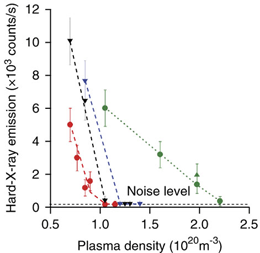Research Abstract
熱核融合炉に必要なプラズマ密度での電流駆動
周辺プラズマの電子温度が高いと、非線形相互作用が減少し、高密度でも波がかなり侵入できるという理論予測に基づいて、FTU(Frascati Tokamak Upgrade)で行われた実験について報告する。
Current drive at plasma densities required for thermonuclear reactors
2010年8月10日 Nature Communications 1 : 55 doi: 10.1038/ncomms1052

ドーナツ形のトカマク装置に磁気的に閉じ込められた重水素プラズマに基づく熱核融合エネルギー研究の進展には、効率の高い電流駆動法の開発が必要である。 これまでの実験では、弱いハイブリッドプラズマ波と結合した外部から送られる高周波電力によって、プラズマ電流を効果的に駆動できることが示されている。 しかし、核融合発電所に必要な高いプラズマ密度では、結合した高周波電力はプラズマコアに侵入しない。これはおそらく、周辺プラズマと波が強く相互作用す るためである。本論文では、周辺プラズマの電子温度が高いと、非線形相互作用が減少し、高密度でも波がかなり侵入できるという理論予測に基づいて、 FTU(Frascati Tokamak Upgrade)で行われた実験について報告する。その結果は、周辺プラズマの影響が弱いため、結合した高周波電力が高密度プラズマに侵入でき、したがっ て、ハイブリッド低電流駆動の有効範囲が核融合炉にとって重要な領域に向かって広がることを示している。
- EURATOM-ENEA(伊)
Progress in thermonuclear fusion energy research based on deuterium plasmas magnetically confined in toroidal tokamak devices requires the development of efficient current drive methods. Previous experiments have shown that plasma current can be driven effectively by externally launched radio frequency power coupled to lower hybrid plasma waves. However, at the high plasma densities required for fusion power plants, the coupled radio frequency power does not penetrate into the plasma core, possibly because of strong wave interactions with the plasma edge. Here we show experiments performed on FTU (Frascati Tokamak Upgrade) based on theoretical predictions that nonlinear interactions diminish when the peripheral plasma electron temperature is high, allowing significant wave penetration at high density. The results show that the coupled radio frequency power can penetrate into high-density plasmas due to weaker plasma edge effects, thus extending the effective range of lower hybrid current drive towards the domain relevant for fusion reactors.

